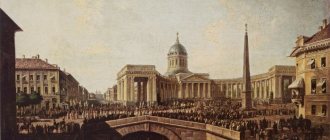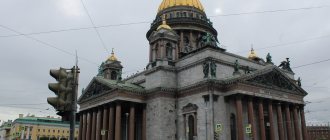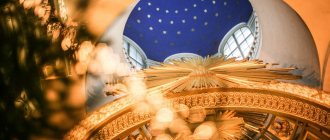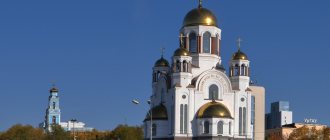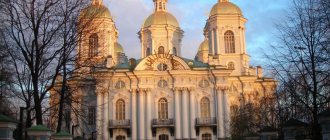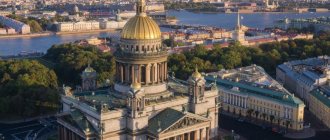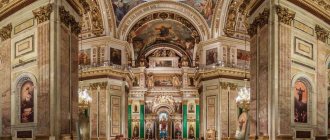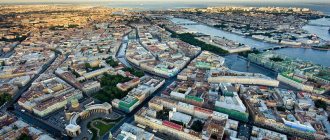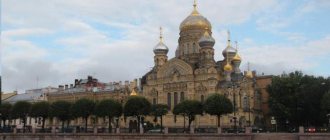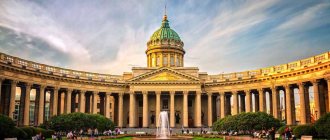The inside of the Kazan Cathedral is no less beautiful than the outside, and its architectural forms distinguish it from other cathedrals. Here everything inside is convex, everything is in bas-reliefs.
It’s really nice to look at and the inside of Kazan is very different from other churches. So in the Cathedral of the Savior on Spilled Blood everything is laid out with mosaics, and in St. Isaac's Cathedral everything is paved with marble.
At the same time, you can take pictures freely.
Kutuzov's grave and war trophies
The great commander M.I. is buried in the Kazan Cathedral. Kutuzov. His grave is located to the right of the main entrance, and immediately above it there are many keys to various cities that were defeated during the campaign against Napoleon.
Kutuzov died during the campaign and his body was delivered to his homeland for another month.
The marching office of the great commander was preserved and after World War II it was transported to Russia; it is now on display in the Artillery Museum
Kutuzov's grave
The priest on the left is consultations on matters of faith
Keys to conquered cities
Kazan Cathedral before 1917
On December 21, 1812, when Russian troops reached the borders of the empire, the Kazan Cathedral became the site of celebration of the complete liberation of the Russian land from the conquerors. In February 1913, the keys of the city of Warsaw arrived at the Kazan Cathedral, which were delivered to the capital by General Vasilchikov.
The grave of Prince M.I. Golenishchev-Kutuzov of Smolensk in the Kazan Cathedral
A special event for the Kazan Cathedral was the funeral of Field Marshal M.I. Kutuzov on June 13, 1813. His grave is located opposite the Kazan Icon.
Kutuzov died on April 16, 1813 in the city of Bunzlau. There his body was embalmed, for which the insides were removed and buried in a local cemetery. Subsequently, a legend arose that the field marshal ordered his heart to be buried at the place of death, on the Saxon Highway, so that the soldiers could see that his heart remained with them. This myth was dispelled in 1933, when Kutuzov’s coffin was opened:
ACT.
Leningrad, 1933, September 4th day. A commission consisting of: director of the Museum of the History of Religion of the USSR Academy of Sciences - prof. Bogoraza-Tan V.G., scientific secretary of the museum Blakanov V.L., head. Funds of the Vorontsov K.K. Museum, in the presence of a representative from the P.P.OGPU comrade. Borozdin P.Ya. drew up this act on the following. The crypt in which M. I. Kutuzov was buried was opened. The crypt was located in the basement of the museum. Upon opening the crypt, a pine coffin was discovered (covered in red velvet with gold braiding), in which there was a zinc coffin, screwed with bolts, inside which a skeleton with the remains of rotten matter was found. On the left, in the heads, a silver jar was found containing an embalmed heart. The entire autopsy process was photographed - 5 pictures were taken. This act is drawn up in 2 copies [Cit. on 2, p. 96]…
The Smolensk Icon of the Mother of God from the Alexander Nevsky Lavra was hung over Kutuzov’s grave.
The Kazan Cathedral was the place from where the Emperor and members of his family went to the active army. Alexander I's return to the capital began with his visit. Until the end of the war with Napoleonic France, the temple remained a place for celebrating the most significant victories of the Russian and allied troops. On September 2, 1813, the capture of Berlin was celebrated here, and one year later - the victory at Brienne and the capture of Danzig. In April 1814 and July 1815, the capture of Paris was celebrated here.
The Kazan Cathedral played an important role in the life of the royal family. Members of the royal house were baptized in St. Isaac's Cathedral, buried in Peter and Paul Cathedral, and married here. Every year in March, the accession to the throne of Alexander I was celebrated here. Every year on August 30, the procession to the Alexander Nevsky Lavra began from here. This day was considered a day off in St. Petersburg.
In the 1840s, the dome of the Kazan Cathedral was covered with light green paint. Later its coating imitated bronze.
On October 26, 1893, the funeral service for Pyotr Ilyich Tchaikovsky was held in the Kazan Cathedral. Due to the huge number of people wishing to say goodbye to the composer, it was decided to allow visitors into the temple with tickets. In total, 8,000 of them were issued. At the liturgy, only Tchaikovsky’s music was used, performed by the choir of the Imperial Opera. From the Kazan Cathedral the funeral procession proceeded to the Alexander Nevsky Lavra, where the composer was buried.
The temple's candle lighting was replaced by electric lighting in 1903.
In 1910, a proposal was considered to restore the figures of the archangels Michael and Gabriel on the pedestals near the colonnades. But neither the government nor the clergy of the Kazan Cathedral had the money for this.
About two weeks before the February Revolution of 1917, on the initiative of the Public and Mobile Theater, a memorial service for V.F. Komissarzhevskaya was celebrated in the Kazan Cathedral.
Architect Voronikhin and his brilliant move
The architect and architect of the Kazan Cathedral, Andrei Voronikhin, was in his youth a serf of Count Alexander Sergeevich Stroganov. It was the count who proposed to the emperor the project authored by Voronikhin, and this project was approved.
The architect himself was what is called a “nugget of the people.” He studied unsystematically, doing more self-education, although he took lessons from famous architects and painters, for example, Bazhenov and Kazakov.
Having become a free man, he traveled abroad, but at the same time continued to work at the count's court. It was Voronikhin who had the brilliant idea of building a huge Colonnade of 96 columns in front of the northern facade.
Orthodox customs required that the entrance to the church be on one side, and the front facade on the other. The avenue itself stretches from west to east. And since the altar should be facing east, towards Jerusalem, the cathedral faces Nevsky Prospekt sideways. The Emperor didn't like this. And then Voronikhin came up with the idea of building a Colonnade. It opens directly onto Nevsky Prospekt, and it is from this side that the cathedral looks amazingly beautiful.
By the way, according to the architect’s plan, the southern part of the cathedral was also supposed to be symmetrically enclosed by a similar colonnade, but this idea of the architect was not brought to life. In 1811, the author of the cathedral project was awarded the Order of St. Vladimir for his brilliant move.
Unfortunately, you can’t walk on it now, everything is surrounded by fences.
Facades and interiors
Interior of the Kazan Cathedral in St. Petersburg
The following materials were used in the decoration of the Kazan Cathedral: Olonets marble, Vyborg and Serdobol granite, and Riga limestone. The outer cladding of the walls is made of Pudost limestone (from a quarry near the village of Pudost, eight kilometers from Gatchina). In total, 12,000 cubic meters of this stone were needed. The team of masons was led by Samson Sukhanov.
The length of the building from west to east is 72.5 meters, from north to south - 56.7 meters. The Kazan Cathedral became the tallest temple of the early 19th century. Its height with the dome is indicated differently in different sources. Thus, in the book “Nevsky Prospekt” it is stated that it is 62 meters [1, p. 94]. Historian P. Ya. Kann in the article “Kazan Square” [4], as well as A. A. Ignatenko in the book “Kazan Cathedral. Pages of History" [7] give another number - 71.6 meters. The diameter of the dome exceeds 17 meters. For the first time in world construction practice, Voronikhin used a metal structure. The outside of the dome was originally covered with dark gray tinned iron.
Four bronze sculptures were placed in the niches of the northern portico: Prince Vladimir (sculptor S. Pimenov), Andrew the First-Called (V.I. Demut-Malinovsky), John the Baptist (I.P. Martos) and Alexander Nevsky (S. Pimenov). At the feet of the latter there is a sword with a lion, the symbol of Sweden. A Russian shield rests on the lion.
The bronze entrance doors on the north side of the building are a copy of the doors of the baptistery (baptismal house) in Florence, by Lorenzo Ghiberti (15th century). They were cast and minted by Vasily Ekimov after the completion of the construction of the Kazan Cathedral. For this he needed 182 pounds and 39 pounds of copper. But Ekimov was not given a consultant who would tell him how to correctly arrange ten biblical scenes on the doors. In the end, he did it arbitrarily. The "Florence Gate" was installed in its place in 1811.
The northern attics above the side passages are decorated with panels in the center of which Moses is depicted. The panel above the eastern passage, called “Moses Giving Out Water in the Desert,” was created by I. P. Martos. Above the western passage there is a bas-relief “Copper Serpent in the Desert”. It was created by I. I. Prokofiev. The author of the bas-reliefs of the northern portico (“Annunciation”, “Adoration of the Shepherds”, “Adoration of the Magi”, “Flight into Egypt”) was F. G. Gordeev.
Iconostasis of the small altar of the chapel of the Kazan Cathedral
Of the bas-reliefs inside the temple, two have survived: “Procession to Golgotha” by F. F. Shchedrin and “The Capture of Christ by the Soldiers in the Garden of Gethsemane” by D. Rachette.
The main altar was dedicated to the Kazan Icon of the Mother of God. The chapel on the right side is consecrated in the name of the Nativity of the Blessed Virgin Mary, where the iconostasis was moved from the old Nativity Church. On the left side there was a chapel in the name of Saints Anthony and Theodosius.
The hall of the Kazan Cathedral really looks like a palace hall. The icons for the Kazan Cathedral were painted by V. Borovikovsky, O. Kiprensky, A. Ivanov, F. Bryullo, K. Bryullov. The interior of the building is decorated with 56 monolithic columns made of red granite, mined on Sorvali Island near Vyborg. The bronze capitals of the columns were created at the Ch. Berd plant by foundry worker Taras Kotov. The floor in the hall is covered with several thousand plates of Shoksha stone and Olonets marble. One of the first visitors described the interior of the Kazan Cathedral:
“The new paintings and all the sculptural works in this Temple are the works of G. Academicians and fellow members of the same Academy, namely: G. Shebuyev painted in the dome a vault with the image of the Lord Pantocrator in Glory, and two under this dome images of Saints Basil the Great and Gregory the Theologian; G. Egorov, local images of the Nativity of the Blessed Virgin Mary and the Descent of the Holy Spirit; G. Bessonov, image of the Last Supper; The Royal Doors of the large iconostasis were painted by G. Borovikovsky.” [Cit. from: 7, p. 29]
The stone pedestals that still stand on both sides of the colonnade were intended for sculptures of the archangels Michael and Gabriel. The sketch of the figures was commissioned from Academician A.I. Ivanov back in 1803. But the Commission for the Construction of the Cathedral rejected Ivanov’s work. The new project was created by sculptor I. P. Martos. By the time of the opening of the temple, he had made figures from plaster and covered them with bronze paint in anticipation of the future casting of figures in bronze. But it was not possible to replace them with bronze ones. The plaster archangels became so dilapidated that they had to be removed in 1824.
The fate of the cathedral was changed by the Patriotic War of 1812. Originally built for an icon, it turned into a storage facility for war relics. Before taking command of the Russian army, Field Marshal M.I. Kutuzov prayed in the cathedral. War trophies were brought here, including 107 army banners and regimental standards of Napoleonic troops, 94 keys to the conquered eight fortresses and 17 cities, and the baton of Marshal Davout. To date, there are six trophy banners and 26 keys in six bundles left here.
In December 1812, General Platov, through Kutuzov, donated silver to the church, which the Russian army had taken from the retreating French. The field marshal proposed, in accordance with the wishes of the soldiers, to make four figures of evangelists from precious metal for the interior decoration of the Kazan Cathedral. Models of the figures were made by I. A. Martos, but the chief prosecutor of the Synod, A. N. Golitsyn, did not like this project. A few years later they decided to use silver to make a new iconostasis. But due to the construction of St. Isaac's Cathedral there was no money for this work. The original iconostasis was replaced with a silver one only in 1836. It was created by the architect K. A. Ton.
The haste during construction quickly led to the crumbling of the plaster inside the building. In 1814 it had to be removed, and along with it the bas-reliefs with images of the evangelists decorating the iconostasis. They were replaced by painting on plaster.
Monuments on the square
The Kazan Cathedral gave its name to the square. Already contemporaries considered it a temple dedicated to the military victories of the Russian army. It is not for nothing that military trophies of the Patriotic War of 1812 were brought to this church. Therefore, monuments to the heroes of this war were erected on Kazan Square - Field Marshal Kutuzov and Barclay de Tolly.
In addition, it was from this place that Kutuzov went to war with Napoleon.
Emperor Alexander decided to perpetuate the memory of the commanders after their death. He issued a decree according to which the sculptures of Kutuzov and Barclay de Tolly would stand on the square directly in front of the Kazan Cathedral. As usual, a competition was announced. But a strange thing happened - leading Russian sculptors refused to participate in it! It turns out that their artistic vision ran counter to the emperor's demands. He wanted the commanders to be depicted realistically, in full military uniform. And the fashion of that time demanded that even the statues of contemporaries look like Roman patricians, in togas and tunics.
Only when, under the next Russian emperor, Nicholas I, a competition for sketches of monuments was again announced, the proposal of the sculptor Boris Orlovsky, who studied in Rome, won. Work began only in 1830. The pedestals were made of polished granite by stonemason Samson Sukhanov, and the letters on it were made of stone rather than bronze for durability. The statues themselves were cast in bronze by master Ekimov in the foundry workshop of the Academy of Arts.
It’s interesting that he got the Kutuzov statue right away, but the Barclay de Tolly statue only on the second try. To make Kutuzov's face look realistic, they used a portrait of the English artist John Doe. His pose is decisive, and even aggressive, it shows his readiness to repel the enemy. And in the figure of Kutuzov himself, a compromise was reached - he is dressed in the ceremonial uniform of a field marshal of that time, but wrapped in a cloak like an antique toga.
Despite the fact that the statue of Kutuzov was created 4 years earlier, both monuments were opened simultaneously, in 1837, in honor of the 25th anniversary of the victory in the Patriotic War against Napoleon. The monuments were even given military honors. They were so popular among the people that they were even surrounded by cast-iron chains, and then by pedestals, so that no one could climb onto the statues.
Train accident
There are many unusual places in the Kazan Cathedral. One of them is hidden in the far corner of the cathedral. If you walk the entire temple from north to south, you will see... Jerusalem. Honestly! There is a recess in the southern wall, and in it is drawn the starry sky and the sleeping Holy City - Jerusalem. In front of this niche stands a wooden crucifix. The niche was ordered to be made in gratitude to God for saving the imperial family. Alexander III with his wife and children, including the heir to the throne, the future Emperor Nicholas II, almost died when returning home from Crimea on an ordinary train. The locomotive suddenly went off the rails. This happened in 1888, October 17 at 14:14.
The crash of the imperial train on October 17, 1888, art. Borki, Kharkov province , photo by A. M. Ivanitsky
The whole family, except for the emperor’s daughter, Princess Olga, was having lunch together in the dining room at that moment. Suddenly a strong shock knocked everyone off their feet, and a terrible roar was heard - 10 cars went off the rails! The floor collapsed and everyone in the carriage fell onto the embankment. And Emperor Alexander... held the collapsing heavy ceiling on his shoulders until all members of his family and retinue got out from under the rubble! He was a man of incredible strength, perhaps even stronger than Ilya Muromets! He could easily twist a steel fork into a bow with one hand. So, thanks to his strength, neither his wife nor children were harmed. And Grand Duchess Olga, who was in her compartment at the time of the crash, was simply thrown onto an embankment.
Portrait of Alexander III, artist Nikolai Schilder
Although such a miraculous salvation, of course, cannot be explained by the king’s physical strength alone. More than twenty passengers from other carriages were killed in this terrible accident. And members of the imperial family received only scratches and minor bruises. In memory of this miracle, the “Jerusalem niche” was made in the Kazan Cathedral, where the emperor hurried immediately after returning to St. Petersburg.
Masonic sign
Many are interested in what the Masonic sign - the All-Seeing Eye - does on the pediment of the Kazan Cathedral. They say that the whole point is that both Emperor Paul I and his heir Alexander sympathized with the Freemasons, and they had influence on the Russian aristocracy.
For example, the main first Russian Masonic lodge was Count Vorontsov. Count Stroganov, the “trustee” of the construction of the cathedral, was also a Mason. However, it was Alexander who subsequently banned the activities of these secret societies in Russia. So what's the deal?
In fact, this symbol - a triangle surrounded by rays - is not at all specifically Masonic. Firstly, the All-Seeing Eye is a purely biblical term. The tradition of depicting him in iconography in this way has been widespread in Western European art since the Renaissance. And with the spread of the classicism style in the 18th century, it penetrated into Russia. Therefore, it is not surprising that many designs of Catholic churches were used to decorate the Kazan Cathedral.
The Masons really often used this sign, but they also did not invent their symbolism, but took it from traditional Christian iconography, simply giving it a slightly different meaning. In their opinion, God is the architect of the Universe, so they loved to depict compasses and triangles - symbols of architecture. In Orthodoxy, such symbols were not very common, but they are still found in wall paintings and icon painting. Historians believe that there is no need to look for any mysterious meanings in the pediment of the Kazan Cathedral, as well as for the special influence of the Freemasons.
Masonic sign above the altar in the Kazan Cathedral
Masonic sign above the entrance to the Kazan Cathedral in St. Petersburg
"Rotten Stones"
Although Voronikhin studied in France and Switzerland and visited many foreign countries, he and his master, Stroganov, loved their country most of all. Therefore, they tried to invite Russian craftsmen and use Russian wealth for construction. So, all the materials from which they decided to build the Kazan Cathedral were ours, Russian: crimson porphyry, gray-black shungite, pink and gray marble, red jasper and various other stones.
But the columns inside the temple were made... from “rotten stone”! It’s not that it was really rotten and rotten - it was just given that name because this stone was mined in the Vyborg swamps, and there it smells of rot. But in fact it is a very durable and beautiful granite.
And you know what else is interesting? The main artistic work on marble in the cathedral was also done not by some eminent sculptor, but by a talented self-taught person named Samson Sukhanov. And the cathedral was built mainly by peasants. They were in a hurry and therefore they worked even at night, in winter, in severe frost! The Kazan Cathedral was ready in the fall of 1811. We made it: less than a year later the terrible Patriotic War began...
The royal seat is a richly decorated tent and throne where the emperor himself sat or stood during worship.
It is located near the altar. The inscription above it was like this: “The heart of the king is in the hand of God,” as the wise King Solomon said.
List of Kazan icons
There are many legends about the icon of the Kazan Mother of God. But first, let's talk about what it is. This is the so-called image of “Our Lady Hodegetria”. Such icons began to be painted in Byzantium, and it is customary to depict the Virgin Mary with the infant Christ. She slightly tilts her head towards the child and supports him with one hand. One of these icons - “Our Lady of Kazan” - was very revered in Kazan. Legend says that after the fire of 1579, which destroyed almost the entire city, the Mother of God appeared to a ten-year-old girl and ordered her to dig up an icon from the ashes. The icon was found, and since then in Russian Orthodoxy there has been a holiday of “The Finding of the Kazan Icon of the Mother of God.”
The icon was recognized as a miracle worker, but it was venerated only in Kazan. In order for similar icons to appear in other places, lists, that is, copies, were made from the prototype. Some of them were also considered miraculous. But there were so many of them that historians are confused about which list ultimately made it to St. Petersburg. It is generally accepted that one of them was sent to Moscow at the request of Ivan the Terrible. And during the Time of Troubles, the militia prayed in front of this copy as they went to fight the Polish occupiers.
Over hundreds of years, many such copies circulated in Russia, but, apparently, the prototype of these icons was kept for a long time in the Kazan Mother of God Monastery.
In 1904, the monastery near Kazan was robbed by the peasant Bartholomew Chaikin, who sold its frame and burned the icon itself in an oven. As for the copy that came to St. Petersburg, Peter I brought it there. For a long time the icon was in the Church of the Nativity of the Virgin Mary, and then it was transferred to the Kazan Cathedral, built on the same place. It is kept in the central part of the cathedral, and many pilgrims come there. In the cathedral itself you can read a lot of interesting things about the history of the icon.
There was a huge line to see the icon, so I didn’t take a photo of it.
Kazan Cathedral after 1917
Kazanskaya Square
For some time after the October Revolution, the temple administration continued to develop its religious activities. At the very beginning of 1918, the rector of the Kazan Cathedral, Archpriest Philosopher Ornatsky, planned to build a cave church here named after St. Hermogenes, which should have replicated the dungeon of the Chudov Monastery in Moscow, where St. Hermogenes died.
But very soon the policy of the Soviet government towards the church led to the fact that its development was out of the question. On the contrary, the number of parishioners was declining. As noted in 1924, on the feast of the Kazan Icon there were only 60 people in the cathedral, mostly old women. Due to the sharp decline in the size of the parish, donations were also reduced. The clergyman did not have enough money to maintain the building.
In the spring of 1924, the Soviet government became concerned about the condition of architectural monuments, which continued to include the Kazan Cathedral. Then the poor condition of the building's roof was revealed, which on September 23 was filled with water in the basements due to the devastating flood. Subsequent restoration of the walls and interiors of the cathedral was carried out by architects A. P. Aplaksin, A. A. Parland, artists N. A. Bruni, E. K. Lipgard.
In April 1932, the Kazan Cathedral was closed to believers. At the request of the USSR Academy of Sciences, work began in the Kazan Cathedral to build the first museum on the history of religion and atheism for the 15th anniversary of October [7, p. 84]. The Kazan Icon of the Mother of God was transferred to the Prince Vladimir Cathedral, other valuable icons, paintings and church utensils were transferred to the Russian Museum. In the temple, only “The Last Supper” by S. A. Bessonov remained on the altar vault, as well as works by artists A. I. Ivanov, G. I. Ugryumov, S. S. Shchukin and F. I. Yasnenko, as well as a painting by F. Alekseev over the grave of Kutuzov. The cross of the dome was replaced with a ball with a pike. The opening of the museum did not take place on time, it happened on November 15. By the fall of 1933, the building received artistic lighting.
Kazan Cathedral
In the fall of 1941, an exhibition “The Military Past of the Russian People” was organized near the temple colonnade. The Museum of Atheism was temporarily closed, and its place was taken by the exhibition “The Patriotic War of 1812”, which ran throughout the war. One of the departments of the headquarters of the Leningrad Front was located in the basement of the building. During the blockade, the Kazan Cathedral was hit by three shells; the dome and roof had more than 1,600 holes. In 1951, its overhaul began under the leadership of Ya. A. Kazakov. Work on the interiors was carried out in 1952-1956, the facades were repaired in 1964-1968.
On January 6, 1990, for the first time in the practice of domestic television, a live broadcast of the Christmas all-night vigil was carried out from the Kazan Cathedral. Similar Christmas and Easter television broadcasts are now held annually.
Since 1991, the Kazan Cathedral has been reopened for worship, and the Kazan Icon of the Mother of God has been returned to it. In 1994, a golden cross reappeared on the dome of the cathedral. On April 6, 1998, the Kazan Cathedral was “returned to its voice”; a bell cast at the Baltic Factory was installed on its belfry. In 2000, the Kazan Cathedral became the main cathedral church of St. Petersburg, and the Kazan Icon was returned here. The Museum of the History of Religion moved to a building on Pochtamtskaya Street. By 2003 (the 300th anniversary of St. Petersburg), craftsmen from the Baltic Plant cast a four-ton bell with a height of more than two meters, which became the largest bell of the Kazan Cathedral.
The most famous cafe overlooking Kazansky
Opposite is the Singer trading house, which is now the House of Books, on the second floor there is a large cafe with huge windows. This is the best Instagram view of Kazansky.
There are always a lot of people, so you will either have to wait 15 minutes or stand by one of the windows.
You can climb to the roof of Singer's house, but it is unofficial and requires a fee.
Interior decoration
The interiors of the cathedral amaze with their splendor. Real masters of painting took part in the painting of the temple - Vladimir Borovikovsky, Fyodor Bruni, Karl Bryullov, Grigory Ugryumov, Orest Kiprensky and other outstanding artists.
Inside there are 56 monolithic pink columns, hewn from beautiful Finnish granite. Each of them weighs 30 tons, has a height of 10.6 m and is decorated with an expressive gilded capital of the Corinthian order. In addition, in the cathedral you can see two stone bas-reliefs on religious themes.
For more than two centuries, trophies and banners of defeated armies taken by Russian soldiers have been kept here. The cathedral houses the marshal's baton of the Napoleonic military leader Davout and the keys to the conquered cities. After restoration, the silver iconostasis was completely restored.
Brief history of creation
Previously, on the site of the Kazan Cathedral there was a simple Church of the Nativity of the Virgin Mary, with a wooden dome and sculptures of the apostles on the cornice. It is often compared to the Peter and Paul Cathedral. Despite the modest decoration of the temple, Emperor Paul I himself was married in it. But he believed that it was too unsightly, and it would be necessary to build some kind of grandiose cathedral worthy of the “Northern Capital”. The model for it was to serve as St. Peter's Cathedral in Rome.
In 1799, the emperor announced a competition for the design of the cathedral, in which many famous architects participated. But Pavel didn’t like any of them. He even seemed to select some projects, but then abandoned them again. And then Count Stroganov presented Voronikhin’s sketches to the emperor. They answered Paul's desire to eclipse Rome.
He not only approved Voronikhin’s project, but also appointed Stroganov as head of the board of trustees, which controlled the progress of construction. By the way, this council told Pavel that the cathedral project did not have a bell tower, and this was a significant drawback. To which Paul stated that if St. Peter's Basilica in Rome does not have a bell tower, then it is not needed here either. Therefore, the bells were placed directly in the openings of the Colonnade.
However, Paul I did not live to see the laying of the first stone of the cathedral. This happened already under his heir Alexander I, who was present during this solemn ceremony. Voronikhin was helped by the famous Russian architect and engraver Nikolai Alferov, and a lot of money was spent on construction - a huge sum for those times, more than 4 million rubles! If we consider that the then ruble was worth the same as 550 today, this means that the construction of the cathedral cost 35 billion US dollars. The cathedral was completed in 1811. It was consecrated by Metropolitan Ambrose. Then the old church was finally dismantled.
Construction of the Kazan Cathedral
Kazan Cathedral. Main facade
By the end of the 18th century, the building of the Kazan Cathedral had become dilapidated and no longer corresponded to the appearance of the ceremonial Nevsky Prospect that had developed by that time.
A competition for the design of a new temple was held in 1797-1800. The task facing the architects involved was extremely difficult. At the request of Paul I, it had to resemble St. Peter's Cathedral in Rome, built by Michelangelo Buonarroti and other outstanding architects of the Renaissance. The new Kazan Cathedral had to have a colonnade similar to the one that Gian Lorenzo Bernini added to St. Peter's Cathedral. Among the tasks assigned to the architects, there was also the need to fit the new monumental building into the already formed architectural space. According to Orthodox traditions, the altar should have faced the east, and the main façade should have faced the west, that is, not to Nevsky Prospekt, but to Meshchanskaya (now Kazanskaya) Street.
From the very beginning, C. Cameron, P. Gonzaga and A. N. Voronikhin took part in the competition. In 1800, J. F. Thomas de Thomon arrived in St. Petersburg, and also managed to submit his project.
Initially, Paul I accepted Charles Cameron's project. But with the support of Count A.S. Stroganov, who was responsible for construction, the work was entrusted to Andrei Nikiforovich Voronikhin. His project was approved by Paul I on November 14, 1800. This decision was widely discussed in society. It was especially pointed out that Voronikhin was a former serf of the Stroganovs (received his freedom in 1786).
In 1800, the “Commission on the Construction of the Kazan Church” was created, headed by Count A. S. Stroganov. She received the broadest powers. The commission managed all the allocations for the construction of the cathedral; it was given state brick factories, Olonets marble quarries and materials from the Pella manor.
In 1801, she reported to the emperor about the need to build a bell tower and houses for the clergy. Paul I refused this request: “Peter has no bell tower in Rome, and we certainly don’t need anything! As for the clergy, these will not be left without housing.” Later, the clergy got a residential building on the corner of Nevsky Prospekt and Kazanskaya Street (Nevsky Prospekt, 25). The bell tower was never built; the bells were placed in openings in the cathedral colonnade.
Paul I was no longer present at the foundation ceremony of the Kazan Cathedral due to the fact that he was killed in March 1801. On August 27, his son, the new emperor, Alexander I, participated in the laying. The newspaper “Northern Post or New St. Petersburg Newspaper” described the celebration as follows:
“Last August, on the 27th day, the foundation was laid for the holy temple in the name of the Most Holy Theotokos, the miracle-working icon of Kazan, in the Highest presence of THEIR IMPERIAL MAJESES, THE GOVERNMENT EMPEROR ALEXANDER PAVLOVICH, HIS Wife Empress ELISAVETA ALEKSEEVNA and HIS Mother Dowager GO MADAMES EMPRESS MARIA FYODOROVNA, Their Imperial Highnesses, Sovereign Tsesarevich and Grand Duke CONSTANTIN PAVLOVICH, Sovereign Grand Duchess ELENA PAVLOVNA and Consort of Her Most Serene Highness Crown Prince of Baden-Baden Karl Ludvich, Consort of His Princess Amalia Friederike and His Surname, as follows: Upon the arrival of THEIR IMPERIAL MAJESIES at 1 o'clock at noon not to the Kazan Cathedral Church of Our Lady, Their Majesties were greeted at the entrance to it by His Eminence Ambrose, Metropolitan of Novgorod, St. Petersburg, Estonia and Vyborg, His Grace Irenaeus, Archbishop of Pskov and Riga and all the most noble clergy in vestments. also by the Members of the Highest Commission established for the construction of this church, before which THEIR IMPERIAL MAJESIES and Their Imperial Highnesses deigned to proceed to the place designated for the construction of the above-mentioned temple, where a marble stone was prepared with depressions made inside it for the position, first of all, of medals with the chest image of HIS IMPERIAL The Majesty of the Sovereign Emperor Alexander Pavlovich and with the inscription on the back, the day of the founding of the temple and the coins of gold and silver of various virtues, in the second bricks of the Yashmovs and Agatovs with the Hungarians of their imperial majesty, and finally called the bronze board and the inscription of the following content: "" "" "" " Year of the Lord 1801 August 27th day, the foundation was laid for this holy temple in the name of the Most Holy Theotokos, her miraculous icon of Kazan, by command of the blessed memory of the Sovereign Emperor Pavel Petrovich, during the reign and under the Highest presence of the Most Pious Autocratic Great GOVERNOR EMPEROR ALEXANDER PAVLOVICH all I of Russia, the Spouse of HIS MOST GOOD MESSES EMPRESS ELIZAVETA ALEKSEEVNA and HIS MOST PIOUS MOTHER, EMPRESS MARIA FYODOROVNA, in the first summer after the Ascension to the THRONE OF HIS IMPERIAL MAJESTY. — Built by Architect Voronikhin.” After the blessing of water and the prayer service, when THEIR IMPERIAL MAJESES and Their Imperial Highnesses deigned to proceed to the above-mentioned place prepared for the laying, the Members of the Commission had the good fortune to present to THEIR MAJESES and Highnesses, as well as to the Most Serene Princes and Princesses of Baden-Baden and Mecklenburg on gilded dishes the following accessories , which were placed on richly decorated tables, namely: Mr. Chief Chamberlain, Senator, President of the Imperial Academy of Arts and Cavalier Count Stroganov - medals and coins. Mister Privy Councilor, Quartermaster and Cavalier Khodnev - blades, Mister Actual State Councilor and Cavalier Starov - jasper and agate with monogrammed THEIR IMPERIAL MAJESES Names bricks. Mister State Councilor Pushkin - a hammer, and in conclusion a gilded bronze plaque with the inscription Mister Architect Collegiate Assessor Voronikhin. In the situation of HIS IMPERIAL MAJESTY, the first stone was fired from both the St. Petersburg fortress and the Admiralty from cannons, one hundred and one shots were fired. Finally, this entire celebration was concluded with the proclamation of many years for the Highest Health, and with these exclamations, THEIR IMPERIAL MAJESTIES and Their Imperial Highnesses, with other High Persons, deigned to return in the same order.” [Cit. from: 7, p. 5-7]
Kazan Cathedral; west side facade
Initially, the Kazan Cathedral was planned to be built by 1804, but in reality the work dragged on for more than 10 years. A cathedral was built south of the Church of the Nativity, and all this time it continued its work. The existing buildings at that time on the corner of Nevsky Prospekt and Meshchanskaya Street and near Zimin Lane were demolished (11 private houses). For each of them, the owners were paid 500 rubles [3].
Preparations for construction took place against the backdrop of a patriotic upsurge. This was the reason why Count Stroganov proposed to build the Kazan Cathedral only by Russian craftsmen, only from domestic building materials.
During construction, Voronikhin moved to house no. on Nevsky Prospekt.
At first, construction workers lived outside the city in dugouts. Some of them were placed in barracks on Konyushennaya Square. The overwhelming majority of builders were serfs and were forced to give all their earnings to their owners. Yaroslavl and Vologda provinces supplied masons for construction, Kostroma - carpenters, Olonets - lapidaries, Belarusian regions - diggers.
The working day of the builders of the Kazan Cathedral in the summer was set from 4 a.m. to 9 p.m. In winter - from 5 a.m. to 8 p.m. The lunch break in summer was 2 hours, in winter - 1 hour. For seasonal workers, the season began in the spring and ended in October. Many of them signed a new contract and promised to return next year. At the same time, the employee’s passport was taken away and an “advance” was given. Salaries during the construction of the Kazan Cathedral were approximately equal to the city average. Masons were paid up to one ruble per working day, but not in silver, but in banknotes. One banknote then cost approximately 80 kopecks. An eyewitness recalled:
“Workers who come for summer jobs—builders, carpenters, masons, plasterers—start work at 5 a.m. and continue until 9 p.m., with a two-hour lunch break... They spend the night outside the city, in courtyards or stables, on the ground. Their food consists of water, kvass, bread, flour or cucumbers; they strain their strength excessively to collect a little money and, upon returning home, bury it immediately in the ground so that their masters or managers cannot take it away, and an accident or death buries the silver forever in the ground.” [Cit. from: 3, p. 32]
Not only quit-rent peasants worked at the construction site. For example, to decorate the temple in 1810, the serf artist Taras Ivanov was purchased from the landowner Teplov for 1,000 rubles.
The builders of the Kazan Cathedral often suffered from their lack of rights. A document has been preserved - a complaint from the builders Mokhnatkin and Chobykin, whom the contractor not only cheated and deprived of their passports, but also ordered them to be chained with slingshots. The chief police officer ignored this complaint.
Foreigners described Russian workers as follows:
“They, these simple men in torn sheepskin coats, did not need to resort to various measuring instruments; having inquisitively looked at the plan or model indicated to them, they accurately and gracefully copied it. The eye of these people is extremely accurate. They were in a hurry to complete the construction of the cathedral; despite winter time and 13-15 degrees below zero, work continued even at night. Holding the lantern ring tightly between their teeth, these amazing workers climbed to the top of the scaffolding and diligently carried out their work. The ability of even ordinary Russians in the technique of fine arts is amazing.” [Ibid]
The military governor of St. Petersburg, Mikhail Illarionovich Kutuzov, provided great assistance during the construction of the temple. At Voronikhin’s first request, he provided territories for workshops and warehouses, and allocated soldiers for urgent and labor-intensive work.
Due to the fact that the main entrance to the Kazan Cathedral, according to the rules of the Orthodox Church, should have been built not from Nevsky Prospect (from the north), but from Kazanskaya Street (from the west), Voronikhin made entrances on both sides of the building. The northern colonnade of the cathedral architecturally united the building with Nevsky Prospekt. The side portals of the colonnade served as passages towards the embankment of the Catherine Canal and Kazanskaya Street.
Project plan of the Kazan Cathedral
The cathedral project was not fully realized. When its construction was coming to an end, the architect proposed building a colonnade on the southern side of the building, which would repeat the northern one, consisting of 96 columns. This idea was even noticed in the notebook of Alexander I for 1819, where he plans the most significant buildings in the center of St. Petersburg. But the southern colonnade was never built.
Back in 1805, part of the land to the west of the cathedral, which until that time belonged to the garden of the Orphanage, was liberated. Here one of its outbuildings was demolished. From the summer of 1811 to November 1812, an artistic fence was erected on this site. On the pedestals at the edges of the lattice there were supposed to be figures of the apostles Peter and Paul. For them, two granite blocks weighing about 1,500 pounds were made near Vyborg. One of them drowned while being loaded onto a barge, and the second fell from the platform while being transported to the temple along the streets of St. Petersburg. For several decades, a piece of rock blocked Aptekarsky Lane. In the end, this stone was useful for the construction of the foundation of the Church of the Savior on Spilled Blood. In 1911, the sunken block was used to make the pedestal of the monument to Admiral S. O. Makarov in Kronstadt.
Construction work was completed in 1811. The last service was held in the old Nativity Church on August 26. Immediately after it, the Kazan icon was moved to a tent installed nearby, after which they began to dismantle the old temple [4]. On September 15, the consecration of the Kazan Cathedral took place. The St. Petersburg press described it this way:
“Yesterday the holiday of the most sacred coronation of the Sovereign Emperor and Sovereign Empress was marked here with a special celebration, on the occasion of the consecration on that day of the newly built Kazan Cathedral Church. This celebration took place in the most brilliant manner in the presence of His Imperial Majesty and the entire August Family. Starting from the Winter Palace to the new Cathedral itself, the troops of the local garrison stood in parade. All the places were dotted with people on all sides, which was also favored by the most beautiful weather. It is impossible to imagine anything more majestic at the sight of the procession of the cross that took place on this occasion, when His Grace the Metropolitan, lifting up the Holy Relics for the new church on his head, and two other Bishops, raising the Holy Icon of the Mother of God, walked around this most magnificent Temple, during the construction of which, It seems that all the arts argued with each other in perfection.” [Cit. from: 7, p. eleven]
Count Stroganov presented Alexander I with the keys to the new temple. Its architect A. N. Voronikhin was awarded the Order of Anna of the second degree and a lifelong pension.
From the completion of the Kazan Cathedral until 1826, a wooden obelisk was located in front of the colonnade. Voronikhin assumed the presence of a stone monument here, but due to lack of funds this was not implemented.
Interior decoration (14 photos)
For the first time in Russia, the architect Voronikhin used a special design made of malleable iron consisting of two ribs for the dome of the cathedral. Its diameter is more than 17 meters. A ball with a cross hangs on it - a symbol of the world order, as well as the chandelier of the temple. In addition to the iron dome, the cathedral has two more brick ones, and they were made not so much according to engineering calculations as according to the architect’s intuition. The church itself is built of brick, but inside, at Paul’s request, it is lined with Pudot stone, which was mined near his beloved Gatchina. And for 56 internal columns with gilded capitals, marble and Finnish granite were used.
In the 19th century, the cathedral looked more majestic and festive than it does now. There were 12 bas-reliefs by famous artists dedicated to the Passion of Christ, but many were removed. Now only “Carrying the Cross” and “Taking into Custody” remain. The main iconostasis installed by Voronikhin was replaced in the 1830s with another one, the work of the architect Ton. But it is not the painting that attracts attention, but the setting of the icons - it was melted down from captured silver taken from the French. But during the Soviet period, the iconostasis was destroyed, and 2 tons of silver were taken away. The salary was restored only recently. The sculptures of the cathedral also practically did not survive, and they were replaced by paintings.
Nevertheless, the cathedral still looks very solemn - it’s not for nothing that it is constantly depicted on postcards. It looks like both grandiose Catholic churches of the Renaissance and an ancient palace. Internal columns and window placement play a huge role in this. If you come there during the day, the light falling from the windows gives the impression that the dome is floating above the temple. The impression is enhanced by rosettes - stylized flowers under the ceiling, made of French alabaster. And the doors of the northern entrance are a bronze copy of the famous “Gates of Heaven” of the Baptistery in Florence.
The floor of the cathedral is made using the mosaic technique and is lined with Finnish marble and quartzite in four colors - black, pink, gray and dark red. The main theme of the mosaic is the Star of Bethlehem. The geometric patterns of the floor themselves are connected with the general plan of the cathedral and help to perceive its interior decoration as one whole. Thus, under the main dome, the floor is decorated in circles, tapering towards the center. This pattern echoes the lines of the dome. The shape and color of the mosaic composition creates the illusion of volume, which further increases the visual size of the temple, and it seems completely huge.
View from a helicopter
If you photograph the cathedral from space, or, for example, take a helicopter and rise into the sky, then, looking at the cathedral, we will see a cross. This is what the architect came up with - to build a temple in the shape of a cross. But if everything had been built as planned from the very beginning, then, looking from a helicopter, one would no longer see a cross, but two letters: “I” and “X”. These are the first letters of the name Jesus Christ, only in Church Slavonic. The letter “I” is formed by the temple, and the letter “X” is formed by two semicircular colonnades. Great idea! But the wars began, and there was not enough money for the second colonnade. So she was left alone.
It took so many years to build the cathedral that one could enter first grade and graduate from school! When it was built, it turned out that this temple was now the largest in St. Petersburg. For the sake of construction, 11 houses had to be demolished and their residents relocated. And to make a huge dome, architect Andrei Voronikhin used metal construction for the first time in history. The project was unheard of at that time!
Where is
You can find this attraction at the address: St. Petersburg, on Kazanskaya Square, house No. 2. It is located near the Griboyedov Canal, surrounded on one side by Nevsky Prospect, and on the other by Voronikhinsky Square. Kazanskaya Street is located nearby. There is a metro station "Gostiny Dvor" within a 5-minute walk. The most interesting view of the cathedral opens from the Terrace restaurant; from here it looks like the picture.
Useful information for visitors
Worship services are held every day. On weekdays - at 9:00 and 18:00, on Saturday and Sunday - 10:00 and 18:00.
There is a small picturesque park in front of the temple. In its center there is a granite fountain, which was transported here from the road leading to Tsarskoe Selo. Tourists like to relax on park benches, feed pigeons, admire flowering flower beds, neatly trimmed bushes and a green lawn. City residents love to have dates and business meetings in the park.
Sunday school for children and adults
The Kazan Cathedral is a center of religious education, where Sunday schools for children and adults are organized. The adult educational course lasts 3 years, but you can become a student at any time. Teaching is conducted by highly erudite clergy in the form of lively dialogues, scientific and educational lectures on the main issues of Orthodoxy. The program includes an introduction to the basics of the Law of God, the Catechism, the Old and New Testaments, the history of the Russian Orthodox Church, etc.
Class hours: Saturdays (September-May), 16.00-18.00.
Sunday School Program for Children
Children's Sunday school students are divided into 3 age groups: junior (5-7 years), middle (8-11), senior (12-17). The program includes the study of the Law of God (the basis of moral education), training in church singing (spiritual and aesthetic education). Children have the opportunity to show their talents in singing, visual arts, participate in various concerts, festive events, and make pilgrimages to holy places. A Sunday liturgy is organized monthly for students.
Timetable of classes:
- Sunday – from 12.00 to 15.30
- Tuesday - 1630 – vocal lessons (individual)
- Saturday – Art classes – 15.30, altar work (boys) – 17.00
Schedule of services
Divine services in the cathedral are held daily. During the day, the Sacraments of baptism and wedding, prayer services and memorial services are performed.
- 07.00 - early Divine Liturgy, confession begins at 07.00;
- 10.00 - late Divine Liturgy, confession begins at 09.30;
- 18.00 - evening service.
Schedule of services for 2021 on the official website
© Marat Safiyulin
Temple of the House of Romanov
The Church of the Nativity of the Virgin Mary was the court church of the Romanov dynasty. A list of the icon of the Kazan Mother of God was kept here - she was considered the patroness of the dynasty. When the Kazan Cathedral was built, it inherited both the shrine and the role of a court temple. All members of the royal family were married here, thanksgiving services were held here after unsuccessful assassination attempts on Alexander II, and the 300th anniversary of the Romanov dynasty was celebrated here.
Gifts from the imperial family were kept in the sacristy of the cathedral: a Gospel in a gilded silver frame weighing more than 33 kilograms, a cross made of lapis lazuli, a golden church cup decorated with diamonds, rubies and mammoth ivory.
